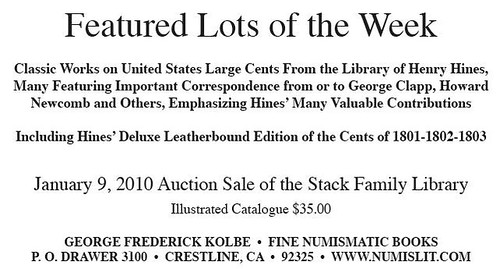
PREV ARTICLE
NEXT ARTICLE
FULL ISSUE
PREV FULL ISSUE
WHEN ARE 200 ONE DOLLAR BILLS WORTH $10 MILLION?
Thank William Smith for this item - he posted a note about it on the Yahoo Colonial Coins newsgroup. I knew about this artwork from a book about Warhol that I acquired while building my collection of the work of "money artist" J.S.G. Boggs. Below are excerpts from the hopelessly pretentious but nevertheless interesting auction lot description from Sotheby's upcoming November 11, 2009 New York sale of Contemporary art.
-Editor

200 One Dollar Bills is the monumental masterpiece from Warhol's first series of silkscreened paintings and is a powerful declaration of the genesis of Warhol's major contribution to art history. Warhol had already revolutionized American art by restoring representation and objective imagery to painting in the startling guise of common, everyday objects such as Campbell's Soup Cans, comics, magazine advertisements and newspaper headlines in late 1961 to early 1962. But the 'Pop Art' revolution was not complete until Warhol discovered the artistic technique that would give him the freedom to exploit his new approach to subject matter. Earlier Warhol had painted projected images and used stencils and rubber stamps, as formalist experiments, but silk-screening would prove to be his perfect muse. Screening was a mechanical process, and represented an intervention between the artist and the canvas; but in his usual contradictory manner, Warhol would subvert his own intention of "mechanized art" by using the process to create an unending variety of images of both beauty and emotional impact, as well as ground-breaking influence. The series of "Dollar Bill" paintings were done in March-April 1962 and Warhol's first silkscreens were created from ink drawings he made on acetate, picturing the fronts and backs of one- and two-dollar bills. The "Dollar Bill" series consist of predominantly small paintings of single dollar bills (some shown front and back), with only 10 paintings of dollar bills done in serial or group formats. .200 One Dollar Bills and .192 One Dollar Bills (collection of Staatliche Museen zu Berlin, Nationalgalerie, Collection Marx, Berlin) are the two largest paintings, one a horizontal format and the other a vertical. In one other important aspect, .200 One Dollar Bills is a quintessential painting of its time: its provenance is the storied collection of Robert and Ethel Scull. The Sculls' fortune derived from taxi cabs and they were New Yorkers to the core. They were also one of the earliest couples to collect and support the Pop Art movement, moving on from their earlier activities in collecting Abstract Expressionist art of the 1950s. There is more than one apocryphal story as to the original source for money as a subject for Warhol. In one story Eleanor Ward, the director of Warhol's first major gallery, the Stable Gallery, claimed that she promised Warhol his first one-man show in exchange for a painting of her lucky two dollar bill. In another version, an art and antiques dealer named Muriel Laptow suggested Warhol paint what he liked best, and his answer was "money." The general basis for most of these stories is Warhol's concept of money as a commodity, and the artist famously spoke of how art could be interchangeable with money hanging on the wall. As the decades pass, Warhol's place in the pantheon of American artists becomes ever more strongly established and the rare major works from the inception of his 'Pop Art' aesthetics, such as .200 One Dollar Bills, are testaments to a pivotal moment in art history. To read the complete article, see: LOT 22 / ANDY WARHOL / 200 ONE DOLLAR BILLS / silkscreen ink and pencil on canvas (catalogue.sothebys.com/pdf/fullpage?auction=N08592&lots=22)
At this month's Nummis Nova meeting I mentioned my longtime Warhol fantasy. Being from Pittsburgh, Andy Warhol's hometown, I've sometimes daydreamed that I somehow got in touch with someone from the Warhola family and purchased a Shot Red Marilyn, one of his silkscreens of Marilyn Monroe. One day a woman came into Warhol's New York studio and fired a pistol at Andy. She missed, but managed to put a bullet hole thru a group of red Marilyns leaning against the wall. This being a fantasy, I bought it for a song because it was well, damaged.
After I got married, a mention of Warhol reminded me of my old fantasy, and I brought it up to date. I could just hear my wife telling me, "Don't bring that thing in our house! The color's awful and it's got a hole in it for crissakes. If you don't get rid of it, I will." So I consign it to Sotheby's and it sells for millions. The Shot Red Marilyn became one of Warhol's most famous works. So the check arrives and I say "Remember that picture you were going to throw out?" Hey, it's my fantasy. It's the only way I'll ever get to say "I told you so" or get the last word in an argument, so let me be.

Wayne Homren, Editor The Numismatic Bibliomania Society is a non-profit organization promoting numismatic literature. See our web site at coinbooks.org. To submit items for publication in The E-Sylum, write to the Editor at this address: whomren@gmail.com To subscribe go to: https://my.binhost.com/lists/listinfo/esylum All Rights Reserved. NBS Home Page Contact the NBS webmaster 
|